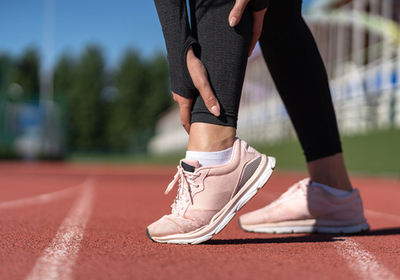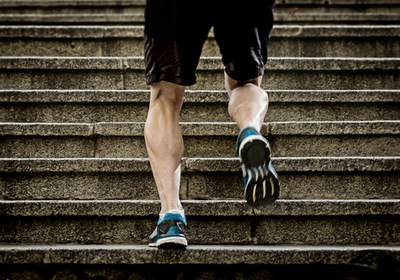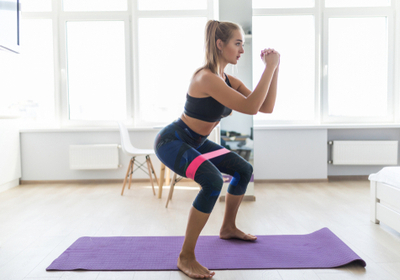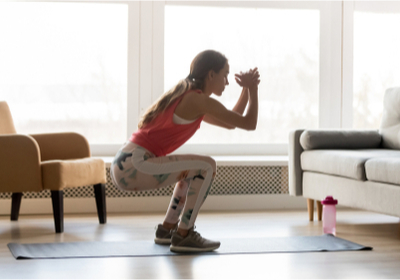VIDEO
Lateral Lunges
- Core
- Legs
- Hips
- Calves
Level:Beginner
Trainer:Ann Summer
Equipment:No Equipment
Start with the standing position, take a wide step with the right leg so your knee angle is 90. Get back to the standing position and do the same with the opposite leg.
save to ...
RECOMMENDED FOR YOU
Side Lunge, Reverse Lunge, Scissor Legs Elbow Plank, Mountain Climbers, Plank V-Ups
- Core
- Trapezius
- Lower Back
Duaration: 00:15
save to playlist
Butt Kicks
- Quads
- Hamstrings
- Hips
Duaration: 00:36
save to playlist
Side Elbow Plank Variation, Elbow Plank Hip Dips, Bicycle Crunches
- Core
- Arms
- Abs
Duaration: 00:15
save to playlist
One Legged Plank Variation
- Core
- Arms
- Legs
Duaration: 00:15
save to playlist
Inchworm Variation
- Core
- Arms
- Abs
Duaration: 00:15
save to playlist
Altitude Drops
- Gluteus
- Quads
- Hamstrings
Duaration: 00:59
save to playlist
Barbell Front Squat, Donkey Kick Variation
- Core
- Biceps
- Upper Back
Duaration: 00:15
save to playlist
Barbell Thruster
- Core
- Biceps
- Triceps
Duaration: 00:34
save to playlist
Bulgarian Split Squat Explosive Jumps
- Core
- Lower Back
- Gluteus
Duaration: 00:45
save to playlist
Dumbbell Side Lunge to Press
- Biceps
- Triceps
- Lower Back
Duaration: 00:44
save to playlist
Superman Sweep
- Arms
- Back
- Legs
Duaration: 00:15
save to playlist
Kettlebell Single Arm Bent Over Row
- Core
- Biceps
- Upper Back
Duaration: 00:37
save to playlist
Dumbbell Obliques
- Core
- Triceps
- Shoulders
Duaration: 00:35
save to playlist
Stair Running, Scissors
- Core
- Biceps
- Triceps
Duaration: 00:15
save to playlist
Dumbbell Step-Up
- Lower Back
- Shoulders
- Gluteus
Duaration: 00:33
save to playlist
Elbow Plank Leg Raises, Bridge Variation
- Core
- Gluteus
- Quads
Duaration: 00:15
save to playlist
Barbell Shoulder Shrugs
- Core
- Trapezius
- Upper Back
Duaration: 00:31
save to playlist
Scissors, Plank Leg Lifts, Crunches, Glute Bridge Variation, Standing Forward Leg Lifts
- Core
- Arms
- Legs
Duaration: 00:15
save to playlist
Plank Crunches, Downward Facing Dog, Vertical Leg Crunches Variation, Double Leg Lifts Variation, Scissors
- Core
- Legs
- Abs
Duaration: 00:15
save to playlist
Ankle Jumps
- Hips
- Calves
- Ankles
Duaration: 00:51
save to playlist
Walking Squats, Lunge Variation, Glute Bridge Variation
- Core
- Back
- Legs
Duaration: 00:15
save to playlist
Sumo Squat Side Crunch, Plank Variation, Reverse Lunge Step Up Jump, Burpee
- Gluteus
- Quads
- Hamstrings
Duaration: 00:15
save to playlist
V-Jumps
- Core
- Legs
- Abs
Duaration: 00:15
save to playlist
Wall Bridging, High Knee Lifts in Half Handstand
- Core
- Arms
- Legs
Duaration: 00:15
save to playlist
Half Handstand Variation with High Knee Jumps
- Core
- Arms
- Legs
Duaration: 00:15
save to playlist
Yoga Strap Stretches Variations
- Core
- Back
- Abs
Duaration: 00:15
save to playlist
Split Squat Press, Russian Twist with Weight, Triceps Kickback, Dumbbell Swing
- Abs
- Triceps
- Upper Back
Duaration: 00:15
save to playlist
Step Up with Knee Raise
- Core
- Legs
- Gluteus
Duaration: 00:33
save to playlist
Dumbbell Squat
- Lower Back
- Shoulders
- Gluteus
Duaration: 00:45
save to playlist
Sumo Squats, Jump Squat, Jumping Lunge
- Legs
- Gluteus
- Hips
Duaration: 00:15
save to playlist
Mountain Jacks, Pullover Leg Raise
- Core
- Quads
- Hips
Duaration: 00:15
save to playlist
Wall Walk Variation
- Core
- Biceps
- Triceps
Duaration: 00:15
save to playlist
Squat Jumps Variation, Crunch Variation, Donkey Kicks, Lunges with Forward Leg Kicks
- Legs
- Gluteus
- Hips
Duaration: 00:15
save to playlist
Straight Arm Glute Bridge, Single Leg Bridge, Bridge
- Legs
- Lower Back
- Gluteus
Duaration: 00:15
save to playlist
Clam Shell in Supine Position, Glute Bridge Knees In And Out, Side Plank Leg Lifts Variation
- Legs
- Lower Back
- Gluteus
Duaration: 00:15
save to playlist
Jumping Lunges, Squat Jumps
- Legs
- Gluteus
- Hips
Duaration: 00:14
save to playlist
One Leg Lunges, Pushups, Long Arm Crunches, Reverse Pushups
- Legs
- Abs
- Biceps
Duaration: 00:15
save to playlist
80 Sprint
- Quads
- Calves
- Ankles
Duaration: 00:33
save to playlist
Side Elbow Plank Side Leg Lifts, Twisted Leg Lifts, Long Arm Crunches
- Core
- Legs
- Abs
Duaration: 00:15
save to playlist
Glute Bridge, Single Leg Glute Bridge, Donkey Kicks Variation
- Core
- Back
- Legs
Duaration: 00:15
save to playlist
Blog
The hamstrings are often underestimated. Usually, training focuses on the quads and calves, but the hamstrings seem to be less important. However, it should be remembered that neglecting any muscle has aesthetic and health consequences that you can avoid by working with it well. The reason you shouldn't forget about these muscles isn't just because of the symmetry and the look of your body. A weak hamstring is one of the most common causes of injuries most professional athletes have.
Best Workouts for Hamstrings
The best way to strengthen your hamstrings is, of course, exercising. So let’s talk about these workouts.
Barbell 90The main benefit of this exercise is that you don't need lots of equipment, just a barbell. Start in a standing position with a barbell on your shoulders, keeping your back straight at all times. Bend your knees slightly, stretch your glutes, and bend forward 90 degrees. Then inhale and return back to the starting position. In addition to the hamstrings, this exercise will also strengthen your glutes and back.
HyperextensionHyperextension is a great exercise for the hamstrings, as well as the muscles in the lower back and glutes. Sit comfortably on the hyperextension machine with your heels firmly resting on the platform at the bottom of the machine. Cross your arms over your chest or behind your head. Smoothly lower yourself down until you feel a stretch in the muscles of the lower back and hamstring while inhaling. Without delay at the bottom point, straighten to the level of the starting position, exhaling. Then return to the starting position. Throughout the exercise, keep your head in line with the body, keep your back straight.
Tights upThis exercise can be performed on two horizontal bars on the playground, or simply put your feet on a chair or bench. We will describe the home workout option.
Sit on the floor with your feet on the chair. Raise the body on your hands so that the tights are up in the air. Bend your knees and lift your tights up so that your body is parallel to the floor. Do 7-8 reps.
One foot and dumbbellsThis exercise works well but requires a nice sense of balance. Take dumbbells in your hands, take one leg back and do not lower it to the floor until the end of the exercise. After that get to the previous position. Repeat this exercise a few times until you are tired.
Final Word
Hamstrings might seem insignificant but it doesn’t mean that you can skip working on these muscles. In fact, strong hamstrings will protect you from many injuries. So do not hesitate and start working on these muscles right now.
Read more
Of course, everyone who is familiar with running knows the importance of strengthening the ligaments of the foot and ankles. Another thing is that sometimes it is hard to spend 5-10 minutes on training for ankle exercises: we dress, tie our laces - and run out into the street. That’s sad. After all, the good condition of the elastic ligaments reduces the risk of pain in the feet. And strong ankle muscles improve the power of the lower back and even the shoulders while running and just walking.
Best Exercises for Strengthening Your Ankles
Of course, there are plenty of good exercises that will help you work out your ankles, so without any further ado, let us have a look at those.
Stretching towardsSit on the floor and straighten your legs in front of you. It is important to ensure that your thumb, little toe, and heel remain in the same direction as you pull the foot over. Only under this condition the muscles will be strengthened and stretched in a balanced way, which will prevent collapse on the outer or inner part of the foot while walking and running. When pulling the foot away from you, try to stretch your toes, as if you are making them longer and do not twist them under the foot. Repeat 15 times.
RollingFrom a seated position with your feet in front of you, pull your feet as close to you as possible. Put your knees sideways, keeping your feet together. Keeping this position of the legs and resting with your hands on the floor, lean your body forward and raise your pelvis above the floor, trying to stay in position for a while. If you feel the potential in yourself, you can roll left and right, touching your feet with your palms.
Ups and downs exerciseTraditionally, they are offered to be done on stairs, but slow doing on a flat surface will give an excellent result. Rise on your toes as high as possible, keep your heels in weight, and then bend your knees, pushing your heels forward. Place your heels on the floor, and only then straighten your legs. It is very important to make sure that your knees and ankles do not roll or fall.
Dumbbell squatsSquats are good for developing your ankles and combined with dumbbells or a barbell (if you're already trained enough), this exercise becomes even more effective. Start with those dumbbells that you can lift 15 times without having to put them on the floor. For beginners, a weight of 2-3 kg is suitable. Bodybuilders need to lift more weight to build leg muscles. Perform squats as follows: stand straight, feet shoulder-width apart, arms with dumbbells at your sides and if you are doing an exercise with a barbell, hold it on your chest or behind your head. Sit down, bending your knees and lowering your buttocks to the floor. Keep your back straight and squat until your thighs are parallel to the floor. The knees should always remain directly over the feet; do not push your knees further than your toes. Push yourself back to the starting position. Do 2 sets of 10-15 squats.
LungesKeep your torso straight and your shoulders back. Step forward and lower yourself until both your knees are at the 90-degree angle. Make sure that your knees do not protrude over your toes. Do two sets of 10 repetitions for each leg.
Final Word
Strengthening ankles is extremely important for both professional athletes and sports enthusiasts, so no matter if sport is your life or you work out just to keep in shape, you still need to work on your ankles.
Read more
The calf muscles are often neglected in the early training stages when people concentrate on working out the chest, arms, and back. As a result, exercises for building calves are postponed or performed extremely rarely, which leads to a lack of progress. The muscles of the lower legs, as well as the deep muscles of the back, practically do not rest during the day, as they have to bear the weight of the body, help maintain balance, and stabilize the joints when walking. This means that it is focused on a low level of development and the way of working with it should be different.Here are some exercises for calves.
Calves 45Among all the exercises this one is aimed at developing the calf muscles, it is also one of the most difficult ones. It's all about changing the angle of the legs, which allows you to use not only the calves but also the soleus. To perform this exercise, you need Gakkenshmidt's Machine. Depending on the design, you will be facing it or not. Set a suitable operating weight. It is calculated as the arithmetic average between the working weights in the two previous exercises. Next, select the weights according to the loads. Then you need to lower the heels, trying to stretch the calf as much as possible. Perform a toe lift. Lock in the position of extreme tension for 1-2 seconds.
Calf raises with dumbbellsThis exercise is designed for athletes of any level and is considered the main one for working out the calf muscles. Stand on a wooden block. You can perform a movement in Smith, getting a step platform under your feet, and put the barbell on your shoulders. Fix the body in a straight position. If additional weight is required, dumbbells or weights should be taken. Next, you need to lower your heels below the level of the bar, trying to stretch the ankle as much as possible. Rise on your toes with a powerful impulse movement. Stay in this position for 1-2 seconds and tighten the calves. Slowly lower and get back to the starting position.
Seated calf raisesThis exercise is great for lazy training and will be a perfect option for beginners. Sit on the machine seat. Place the toes of the feet on the support step. Lower your heels to the floor as much as possible. Lower the lever with soft stops on your knees and lock.
Leg pressLie on a leg press machine. This uncommonly effective device for working out the legs can be used for training the calf muscles. Look for the platform where the legs would be straight. Fix the speed. You only need to do two actions. Remove the platform from the stops and squeeze it out with your toes. Return the socks to their original position.
It is important to know that the effect of posture on the development of the lower leg and calf muscles is much stronger than the effect of training. Flat feet, if not taken into account and not compensated, also interfere with bringing the shape of the lower leg. To improve your calves without exercising machines, you can simply choose the right shoes and adjust your gait.
Wrapping Up
Developed calves not only help you perform certain exercises better but also make your legs look simply gorgeous. Therefore, take another look at these exercises and make sure to at least give them a try while working out next time.
Read more
Everyone wants to have beautiful hips. Unfortunately, it's not that easy to keep it in a nice shape. We have some exercises that will definitely help you work your hips out.
Best Workouts for Hips
Beautiful hips require some effort, so let’s take a look at some exercises for hips.
CrossingsThis deep inner thigh stretch will improve your hips and give you a boost of energy. Spread your legs wide with your feet facing outward. Bend your knees and lower yourself into a squat. Put your hands on your hips just above the knees, deepening the squat and stretching even more. Jump up and place your right foot in front of your left one, while landing, you should straighten and cross your legs. Return to the starting position and repeat the exercise with the other leg. Repeat the exercise, alternating legs, as many times as you can, for at least 40 seconds.
Knee squatsSquats with knees together are much better than regular squats for strengthening the inner thighs, quads, and hamstring. And in order not to waste your time, you can work on your hands at the same time. Stand up straight with your feet together. Take dumbbells, bend your elbows and touch the shoulders with the dumbbells. Do a squat with your knees bent and your hips back as if you were about to sit in a chair. Keep your legs together during the entire exercise. The weight should be on your heels. Now stretch your arms up. Return to the starting position without putting your weight on your toes. Do 10 reps.
Elbow plank with raising legsAdd leg raises to your regular elbow plank to improve the hips. Lie on your side, bend your right arm at the elbow and lean on it. Extend your legs so that your body becomes one straight line. Try to rest only on the outer edge of your right foot. Place your left hand on your thigh. Feel your spine stretch and your abs tighten, then lift your left leg just above your hip. Slowly lower it back down. Do not bend at the waist or lean on your shoulder, keep your weight on your elbow. Do about 15 reps for both sides.
Swings with bent legsThis is one of the most popular exercises for strengthening the buttocks and hips. It is suitable for everyone, does not require additional equipment, and does not involve the spine. With the help of swings, the back, front, outer and inner thighs are worked out - combo. Start in plank, palms - under the shoulders, knees - under the pelvis, keep the position of the back. On the exhale, we swing our leg, pushing the heel up; we perform 20 repetitions on each leg and four sets total.
Side lungesIf you are doing this exercise for the first time, you will not need dumbbells - first master the movements of the legs. Take a dumbbell in your right hand, lunge to the left, lowering your right hand to your right leg. Lower your hips as low as possible, resting on your heels. The toes are facing forward, the angle of the bent leg is 90 degrees. Pushing off with your left foot, go into a courtesy pose: the left leg goes back, and the right one goes forward. Raise your arm with the weight up. Both legs face forward. Keep your hips and legs taut. Repeat without returning to the starting position, but immediately moving from a squat to a side lunge. Do three sets of 10 reps, then switch sides.
Final Word
Beautiful hips are a reality if you know what to do, so why don’t you give these exercises a try and see everything yourself?
Read more
Every athlete gets injured sooner or later, especially runners, and most injuries are in the ankle joint, inner and outer parts of the foot, etc. What can be the reason? Too much training, weights, and the distance you actually run. It can be too difficult for feet because all our lives we walk in footwear, most people live a “lazy lifestyle”, which is why ankles and feet do not properly develop. So if one day you just start to run many kilometers the muscles of the foot will be overloaded - this leads to various injuries and inflammations.
Exercises for Strengthening Feet
Obviously, in order to be able to do any exercises safely and without any consequences for your health, you have to train your feet. So let us take a brief look at some of the exercises for these muscles.
Warm-upsSit down, concentrating on your toes. Raise your thumb up. At the same time, press the remaining 4 fingers to the floor. Hold this position for 5 seconds. Now press your thumb and lift the other 4 fingers up. Hold for 5 seconds. Repeat 10 times for each leg.
A knotTake a rope of medium thickness, about a meter long. Place the rope on the floor and sit on a chair in front of the rope. Pinch both ends of the rope with your toes. Try tying a knot. Do the exercise for 5 minutes. Attention: this is quite a difficult exercise.
Feet writingPut a piece of paper on the floor. Sit in a chair and place one foot on a piece of paper. Grasp the handle with your thumb and forefinger. Try to write any word, for example, 'Mom'. Do the exercise for at least 3-5 minutes. Attention: this exercise is quite difficult! Do this exercise for 3-4 minutes.
RollingSit in a chair. Keep your back straight. Place a tennis ball under your foot. Roll the ball back and forth. Don't forget your back. Do not relax and keep it even. Do this exercise for 2-3 minutes. Repeat with the opposite leg.
TowelSit in a chair and place a towel under your leg. Grab the towel with your toes. The heels should be flat on the floor. Bend and unbend your fingers as you slowly pull the towel towards you. Change legs and repeat the exercise. Do 2 sets of 10 reps. You can do more If you want.
Toes upYou can do this exercise anywhere, even in the office while you work at your desk. Sit with your feet flat on the floor. Raise your toes so that your foot arches. Slowly lower your toes while maintaining arch, so you can feel the tension in the arch of your foot. Hold this position for 5 seconds and then relax your feet. Do 5 reps for each leg.
Wrapping Up
Strong feet will enable you to safely do plenty of exercises, so do not underestimate feet workouts and do them at least a couple of times a week.
Read more
SAVE TO ...





